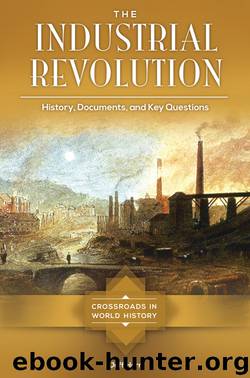The Industrial Revolution by Jeff Horn

Author:Jeff Horn
Language: eng
Format: epub
ISBN: 9781610698856
Publisher: ABC-CLIO
SLATER, SAMUEL Samuel Slater was an English emigrant who became known as the “father of the American Industrial Revolution.” Slater was a self-nominated industrial spy who took advantage of the rewards offered by various U.S. states to provide the latest model cotton textile machines from England. Between 1790 and 1835, Slater and his partners set up mills that were the first of their kind in North America, though they had existed for generations in Europe. They could not compete internationally; they survived only because of a high degree of government financial support and tariff protection. Slater and his partners also benefited greatly from the conflict between the United States and the United Kingdom that ultimately led to war in 1812–1815.
Born in England to a wealthy family, Samuel Slater (1768–1835) was apprenticed to Jedediah Strutt, one of Richard Arkwright’s first and most important partners. From Strutt, one of the largest textile manufacturers in Britain, Slater learned both management and the technical side of manufacturing. In 1789, he finished his apprenticeship, which included a stint as a mill supervisor, and decided to emigrate to the United States. He was drawn by the hefty bounties offered by several American states to anyone who could bring or build the latest model cotton textile machines. Slater arrived in New York, but he was disgusted by the machines and organization of the group that offered the bounty. Instead, he moved to Pawtucket, Rhode Island, to work with Quaker merchant Moses Brown who had employed a number of skilled workmen and constructed several prototype machines.
Slater rejected Brown’s existing designs. Instead, from memory, he drew up plans for the Arkwright carding machine and spinning frame and then had the craftsmen assembled by Brown build the machines. The mill began operation in 1790 with workers walking on treadmills to power the machines; the following year, this plant became the first U.S. factory to produce cotton yarn with water-powered machinery. It operated on the British pattern: 12 hours a day, 6 days a week with a heavy complement of child laborers aged 7 to 12 who worked for very low wages. Slater became a partner, but soon formed another firm that built a separate mill in Pawtucket. Both mills made yarn that was sold to independent weavers. These enterprises were kept going by the embargo on British goods imposed in 1807. The ban enabled Americans to replace temporarily the British in many domestic markets. Later, Slater founded a number of other mills for both cotton and wool scattered around New England, including one at the modestly named Slatersville (now part of North Smithfield), Rhode Island. These water-powered mills contained both spinning and weaving operations within the same factory building and became quite widespread after 1815.
Slater elaborated a deeply paternalistic approach to finding and disciplining labor. He recruited young, unmarried women and recent immigrants. At Slatersville, families lived and worked in the community surrounding the mill. Tenement houses, a store, and even a Sunday school (the first one in a factory in the United States) were provided for the workforce by the company.
Download
This site does not store any files on its server. We only index and link to content provided by other sites. Please contact the content providers to delete copyright contents if any and email us, we'll remove relevant links or contents immediately.
International Integration of the Brazilian Economy by Elias C. Grivoyannis(85028)
The Radium Girls by Kate Moore(11851)
Turbulence by E. J. Noyes(7888)
Nudge - Improving Decisions about Health, Wealth, and Happiness by Thaler Sunstein(7449)
The Black Swan by Nassim Nicholas Taleb(6935)
Rich Dad Poor Dad by Robert T. Kiyosaki(6306)
Pioneering Portfolio Management by David F. Swensen(6161)
Man-made Catastrophes and Risk Information Concealment by Dmitry Chernov & Didier Sornette(5870)
Zero to One by Peter Thiel(5629)
Secrecy World by Jake Bernstein(4588)
Millionaire: The Philanderer, Gambler, and Duelist Who Invented Modern Finance by Janet Gleeson(4282)
Skin in the Game by Nassim Nicholas Taleb(4118)
The Age of Surveillance Capitalism by Shoshana Zuboff(4108)
The Money Culture by Michael Lewis(4016)
Bullshit Jobs by David Graeber(3982)
Skin in the Game: Hidden Asymmetries in Daily Life by Nassim Nicholas Taleb(3862)
The Dhandho Investor by Mohnish Pabrai(3626)
The Wisdom of Finance by Mihir Desai(3597)
Blockchain Basics by Daniel Drescher(3418)
